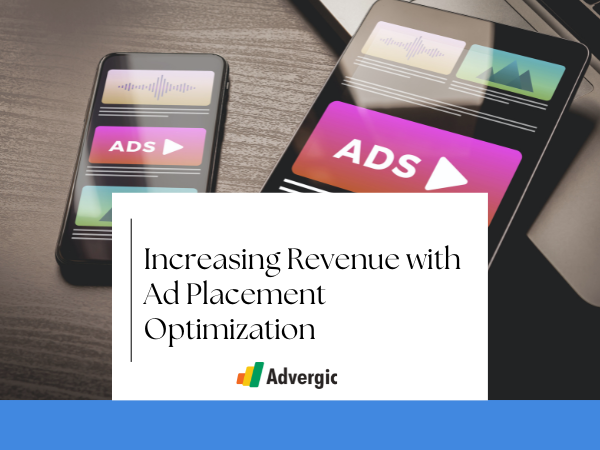Providing a great user experience relies heavily on optimizing ad placements. Ads on a website alone, though,…
Providing a great user experience relies heavily on optimizing ad placements. Ads on a website alone, though, won’t bring in the big bucks. Ad placement optimization is the process by which publishers find and use the most effective ad forms and positions.
Improved outcomes, higher CPMs, and ad relevance are what a publisher dreams of. Put your worries aside because we have gathered the best ad placement strategies for publishers like you.
You may ask, “How do I decide where to put ads?” Should I place ads wherever I find a place available? Is it better to put them below the fold or above? How much room do you think advertisements should have on the page?
All of these questions, as well as suggestions on how publishers can improve their ad placements, will be addressed in this blog post. Publishers can boost ad revenue and enhance user experience by implementing these suggestions.
Considerations for Ad Placement Optimization
Optimizing ad placements is an important part of ad ops management and it involves many considerations. You can increase your income significantly after you have a plan. Some crucial factors to think about are:
- Ad placement
- Ad format
- Ad relevance
- Ad frequency
Best ways to Ad Placement Optimization
One important way for publishers to make more money is to find the best places to place ads. You can make use of these best practices to make sure that ads are put in the best way possible.
Think about the User Experience:
When placing ads on a website, user experience is very important. Based on a study,
When a website takes a long time to load, it can make users unhappy and make them less likely to come back. Users can become very unhappy with even a 2-second wait on unfamiliar sites.
More people will click on ads if they don’t disrupt your users’ flow while they’re on your site. Advertisements should
- Placed in a way that makes them hard to mistake for part of the website’s style or content.
- Never get in the way of how users are interacting with the page they are viewing.
- Not make it harder for users to browse or take up too much memory on their devices (laptop, phone, or tablet).
Also, the ads should be related to the content. A study from GlobalWebIndex says that
Around 29.2% of people like ads that are related to who they are or what they’re interested in.
Another DISQO poll of about 1,000 people found that,
81% of those who answered feel good when they see an appropriate ad with 51% feeling positive and 30% feeling extremely positive.
While both behavioral and contextual data can help make ads more relevant to users, using contextual data is the more privacy-friendly option. Advertising travel packages next to posts about travel or sports in articles about sports are just two examples of how you can target your audience depending on their interests.
Consider Using Various Ad Sizes:
If publishers use multi-sized ad placements on their websites, they can increase their ad revenue by giving advertisers more options for ad sizes, which increases the chances of ad placements and clicks.
In addition, they let publishers fine-tune the placement and layout of their advertising, making sure that they blend in with the site’s aesthetic while still grabbing people’s attention.
Implement Lazy Loading:
Lazy loading is a method for improving website performance by minimizing the amount of time it takes to load content. This method can greatly enhance the user experience by decreasing page load times. It is especially helpful for websites that have a lot of media on them, such as photographs, videos, and advertisements.
Publishers can maximize ad placement by using lazy loading, which only loads ads when the user is actively viewing them. In order to increase the overall efficacy of the ad campaign and decrease the amount of ad impressions wasted on users who never see the ad, this strategy is really helpful.
Also, by easing the strain on the servers, lazy loading can make pages load faster and keep users engaged for longer.
Strategically Position Ads:
To maximize the effectiveness of any advertising effort, it is essential to place ads in strategic locations. Publishers can increase the likelihood of attracting the attention of their target audience, leading to more clicks and conversions, by precisely placing their ads.
There are a number of highly effective ad locations, including:
- In between paragraphs: Ads placed between paragraphs of content can captivate viewers without disrupting their reading experience.
- Above and below images: Placing ads above or below images increases their visibility and draws the user’s attention.
- Sticky Units: Even when the user scrolls the page, Sticky Ads stay put. This method ensures that an ad remains in view and does not vanish when users navigate through the site.
Try Different Ad Positions:
There is a wide variety of ad locations, and each has advantages and disadvantages. One way to find out which formats and placements bring in more money is to do A/B testing.
For instance, you can experiment with a display ad at the page’s top and a native ad on the right rail. You may also compare various banner and text link sizes to find which one generates more revenue.
You can divide your audience into two groups and try out two ad sizes by showing half of your visitors one size and the other size to the other half. In subsequent campaigns, the optimal size will be applied to all visitors.
Optimizing for Mobile Devices:
The online advertising scene is rapidly evolving to include mobile devices, which are both popular and significant. A study predicts that mobile advertising will account for 51% of total ad spending after 5G is made more widely available.
Mobile ad optimization is becoming more important for publishers as the number of people using mobile devices continues to rise. Ads should be placed in places where mobile users can easily see them and use responsive ad units.
A responsive ad unit adapts its size automatically to the screen resolution of the user’s device. This means that the publishers do not have to create custom sized creatives if they use responsive ads.
Ads served in mobile-friendly sizes are another optimization tactic. This indicates that they are not overly large and include minimal text or other components.
Taking Steps to Optimize Ad Placement
Ad placement optimization may not be as complicated as it seems once you take action. You can enhance your content’s engagement, change your website’s structure, or implement new advertising strategies.
You have a lot of flexibility to choose from, but it all comes down to your objectives and the obstacles you’re up against. We cannot tell you which strategy is optimal for your website. The only way to discover is to do something and then see what happens.

